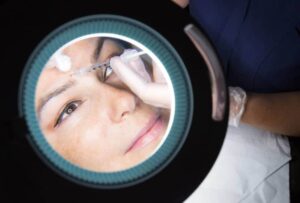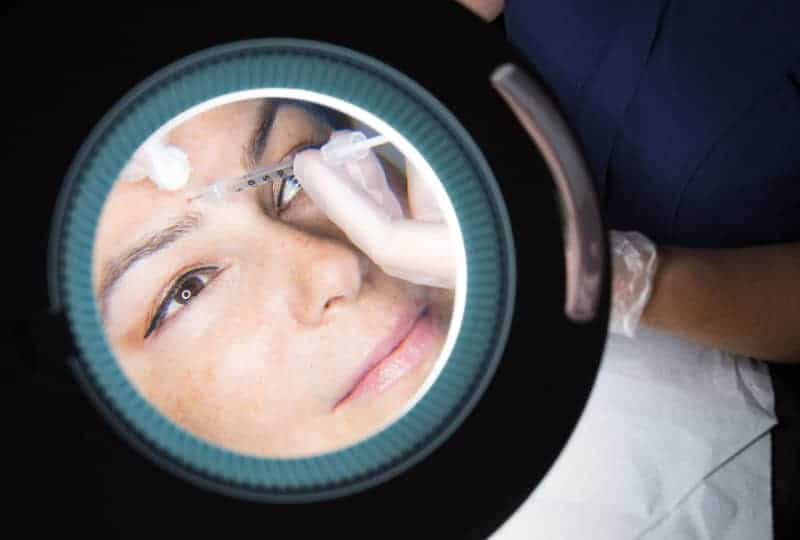
DPA

Since the first lockdowns of March 2020, cosmetic surgery specialists have been reporting a dramatic rise in requests for minor facial procedures in the wake of the global shift to remote working.
The way we perceive our own face in video chat programs like Zoom is typically more negative than our the mirror image, says Joerg Blesse, who heads the annual conference of the German Society for Aesthetic Plastic Surgery (DGAePC).
He’s one of many surgeons around the world who linked a surge in demand for facial procedures this year and last to the rise of Zoom and other video conferencing tools as millions were asked to work from home during lockdown.
In Britain, in the weeks after the first lockdowns of 2020, the British Association of Aesthetic Plastic Surgeons (BAAPS) was already forecasting a “Zoom Boom” during the pandemic and noting a 33 per cent rise in men and 66 per cent rise in younger women seeking virtual consultations about plastic surgery.
In the US, 64 per cent of plastic surgeries were reporting an increase in their telemedicine consultations by June 2020.
The trend appears to be continuing and according to a 2021 survey of DGAePC patients in Germany, procedures to beautify the face without major incisions – like operations to have the eyelids tightened – are much more in demand in 2021 than in previous years.
This is also evident in the statistics of the country’s largest professional society, the Association of German Aesthetic Plastic Surgeons (VDAePC).
So what it is about Zoom that’s makes people all over the planet want to change their faces?
“Many then think to themselves: ‘Oh, that’s me there’,” says Blesse and then focus on their face during much of a meeting.
But the way we look at our faces in Zoom is also different to the way we see ourselves in the mirror or take selfies with our phones, researchers say.
“Unlike the still and filtered selfies of social media, Zoom displays an unedited version of oneself in motion, a self-depiction very few people are used to seeing on a daily basis,” write the authors of a November 2020 study on the impact of Zoom on self-perception.
Unlike in real-world conversations, where we don’t see our faces, let alone compare them to those of others, in Zoom we are constantly shown what we look like.
“This may have drastic effects on body dissatisfaction and desire to seek cosmetic procedures,” say the authors of the paper, published in Facial Plastic Surgery & Aesthetic Medicine.
“In addition, cameras can distort video quality and create an inaccurate representation of true appearance,” authors Shauna M. Rice, Emmy Graber and Arianne Shadi Kourosh write, noting that the size of a nose can be distorted by different lenses and their distance from the subject.
“Webcams, inevitably recording at shorter focal lengths, tend to produce an overall more rounded face, wider set eyes and broader nose.”
Not only that, but the person confronted with their own face at length during online meetings can also be emotionally impacted by what they see in themselves. What you might see as wrinkly or tired-looking eyes can lead you to perceive yourself as sad or tired as a result, the researchers write.
We shouldn’t attribute the rise in cosmetic surgery entirely to video chat however, and Blesse notes that the obligation to wear a mask has also drawn more attention towards the eyes.
In any case, the rise in minor facial procedures due to a more intensive preoccupation with self-image is also worrying many specialists in Germany.
For more and more people, the threshold for such minimally invasive procedures is much lower than for more complex operations, says Harald Kaisers, president of surgeon association DGAePC.
“We are particularly critical of the presentation of such aesthetic plastic treatments on social media. There is a lot of information, but not explanation.”
Influencers on platforms such as Instagram, who present such treatments as a lifestyle product and not as a medical intervention, also contribute to this.
Those who want to have Botox or hyaluronic acid injected do not necessarily have to consult a specialist. Such “filler materials” against wrinkles are medical products, VDAePC President Steffen Handstein says.
“Anyone can purchase them. It’s quite a bizarre situation. There are many places that can do it legally, although they could not treat possible complications.”
On platforms like YouTube, there are even video instructions to inject yourself with hyaluronic acid, says Kaisers. “You can go blind if you inject it incorrectly.”
The two associations are therefore calling for greater restrictions on the business of such treatments. “This belongs in the hands of specialists,” Kaisers said, stressing that the trend towards such minor interventions is likely to continue even after the pandemic.


Recommended Comments
There are no comments to display.